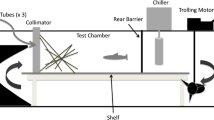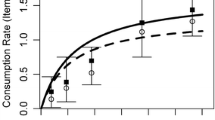Abstract
Many of the world's most productive aquatic ecosystems usually contain turbid water. Paradoxically, many fish species that live in these habitats are also those that often rely on vision to detect their predators and their prey. For these fish, turbidity will reduce the distance at which predator-prey interactions occur, and there should be a reduction in the opportunity for behavioural modification to control the risk of predation. Under these conditions, we predict that most antipredator behaviour will become ineffective and that predator-prey interactions in turbid water will be primarily characterised by the direct effects of predator consumption of prey, rather than behavioural modification reducing the growth rates of prey. This hypothesis was tested in two laboratory experiments. The first experiment investigated how water turbidity, risk of predation, and their interaction affect habitat choice decisions by fathead minnows (Pimephales promelas). These data demonstrate that fathead minnows reduce their use of dangerous habitats, but that this effect is diminished in turbid water. A second experiment examined mortality patterns when these fish were preyed upon by yellow perch (Perca flavescens) in clear and turbid water. Absolute mortality rates were unaffected by visibility, but patterns of mortality were random in turbid water and skewed towards smaller individuals in clear water. Combined, these results support our hypothesis and suggest that the impact of predation risk will be reduced in turbid aquatic ecosystems.
Similar content being viewed by others
Author information
Authors and Affiliations
Additional information
Received: 23 May 1996 / Accepted after revision: 18 November 1996
Rights and permissions
About this article
Cite this article
Abrahams, M., Kattenfeld, M. The role of turbidity as a constraint on predator-prey interactions in aquatic environments. Behav Ecol Sociobiol 40, 169–174 (1997). https://doi.org/10.1007/s002650050330
Issue Date:
DOI: https://doi.org/10.1007/s002650050330




